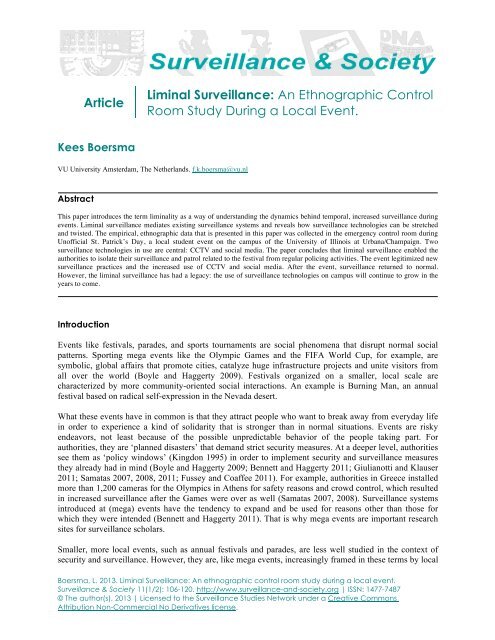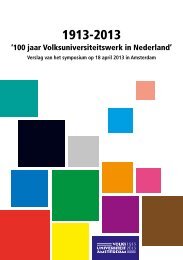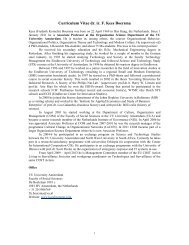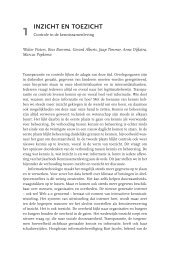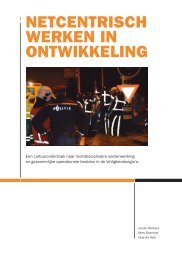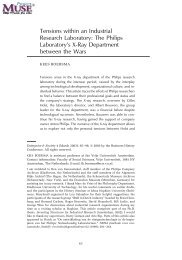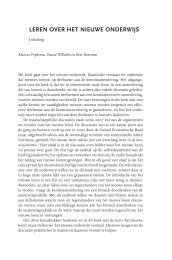Surveillance and Society - Kees Boersma
Surveillance and Society - Kees Boersma
Surveillance and Society - Kees Boersma
Create successful ePaper yourself
Turn your PDF publications into a flip-book with our unique Google optimized e-Paper software.
<strong>Boersma</strong>: Liminal <strong>Surveillance</strong>contextualize Unofficial 2012. Finally, the data posted on social media websites, including Facebook,PicFog <strong>and</strong> Twitter, provided a wealth of information about student behavior <strong>and</strong> excitement during theevent that otherwise would have been missed, although no systematic content-analysis of social mediawebsites related to Unofficial was undertaken.The Event: Unofficial St. Patrick’s DaySince 1996, the first weekend of March at the University of Illinois at Urbana/Champaign has been calledUnofficial St. Patrick’s Day or, in short, Unofficial. The ‘official’ St. Patrick’s Day is a cultural <strong>and</strong>religious holiday, celebrated internationally, commemorating St. Patrick <strong>and</strong> the day he arrived in Irel<strong>and</strong>.Starting as a Christian festival in the 17 th century, it gradually grew into a celebration of Irish culture in amuch broader sense. It has been popular in the USA since the late 18 th century, when the Irish diasporabegan organizing festivals. Later it became a holiday for non-Irish Northern Americans as well. The colorof the festival is green, the Irish color: people wear green clothes during the festival, printed withshamrocks, a three- or four-leaved plant, the festival’s token. People, mostly students, wearing theseclothes are called ‘the Greens’. At the University of Illinois at Urbana/Champaign the event is calledUnofficial because St. Patrick’s Day, March 17, often falls during the university’s Spring break. Local barowners took the initiative to replace the event to a weekend before the actual St. Patrick’s Day in order tosecure their income. It grew into an annual local event attracting thous<strong>and</strong>s of young people from outsidethe Twin Cities, as Urbana <strong>and</strong> Champaign are often called. For most of them the event is about excessivedrinking <strong>and</strong> self-expression (<strong>and</strong> to experience ‘communitas’). Most of the students begin the festivitieswith ‘kegs <strong>and</strong> eggs’ at 6:00 am <strong>and</strong> continue drinking until late at night. Colorful pictures of theirbehavior can be found on Facebook <strong>and</strong> other social media websites. The activities related to the festivalare not concentrated in one location, but spread out informally over the Twin Cities. Most of the activities,however, are on or near campus <strong>and</strong> take place inside local bars <strong>and</strong> in the students’ apartments <strong>and</strong>dorms. There is a plea to make Unofficial an ‘official’, legal event through the organization of concerts orparades, like at the New Orleans’ Mardi Gras festival (for this opinion see The Daily Illini: Weber 2012).Previous Unofficials have got out of h<strong>and</strong>, resulting in dozens of intoxicated young people, under-ageddrinking, <strong>and</strong> even casualties due to accidents directly related to the festival (Editorial 2012; Betz 2012).That is why the authorities announced severe restrictions after the first Unofficial was held, which caughtthe authorities by surprise. In 2012, shortly before the start of the event, Tomaz Betz, the director ofStudent Legal Services, wrote in The Daily Illini, the independent student-newspaper:Underage possession of alcohol, fake ID, disturbing the peace <strong>and</strong> disorderly conduct areall misdemeanors under state statutes that can involve being processed at the ChampaignCounty Jail, which means fingerprints <strong>and</strong> the potential of a permanent criminal record.(Betz 2012)Increased surveillance <strong>and</strong> a zero tolerance policy have emerged as a result of the authorities’ riskmanagement (Schenk 2011). This includes the intensified use of the campus CCTV system.Liminal <strong>Surveillance</strong> during UnofficialThe CCTV systemIn early 2010, university authorities adopted a CCTV surveillance system based on Milestone videomanagement software on campus. The Milestone software is Internet Protocol (IP) based <strong>and</strong> enables theuser to centralize the system: “If security is decentralized on a major university then police cannot use thatsystem to its maximum capacity,” Police Chief Barbara O’Connor said in a public interview. “We havedeveloped a policy where anyone on campus purchasing a camera system must have it approved by thechief of police” (NetworkCentric Security 2010). The reason for the implementation of cameras was<strong>Surveillance</strong> & <strong>Society</strong> 11(1/2) 111
<strong>Boersma</strong>: Liminal <strong>Surveillance</strong>campus crime, especially the increasing theft of laptops from the university library, the university’s foodstores, <strong>and</strong> sexual assault in university buildings. The implementation of the project began with theinstallation of just a few cameras, but by 2012 the system consisted of about 700 cameras <strong>and</strong> the idea isto exp<strong>and</strong> it further in the years to come. The cameras are owned by the University of Illinois, meaningthat there are only cameras within or on the exterior of university buildings, not in other parts of the TwinCities.The university campus CCTV system consists of different types of cameras: 1) fixed cameras permanentlypointing in a single direction such as toward parking places, entries of cafes, or junctions; 2) outdoorbusiness cameras (like dome cameras), installed on the facades of buildings <strong>and</strong> parking garages; 3) PanTilt Zoom (PTZ) cameras, which are the most sophisticated ones: digital cameras with zoom options, 360pan, controllable via the internet. Side-to-side, up-<strong>and</strong>-down movement options can be used to watch‘hotspots’ on campus such as the bigger parking lots, large student buildings, <strong>and</strong> squares.The images recorded by the cameras are stored for 30 days, which is the policy of the University ofIllinois Police Department. During ‘normal’ days of operation the images of the CCTV system are notviewed in real time, because it would be too time-consuming <strong>and</strong> dem<strong>and</strong> too much staff, as the operatorof the system explained:…with so many cameras: how can you do that? You know. You might be able to monitor,but even when you monitor half a dozen screens, <strong>and</strong> put twelve cameras on each one, youstill need ten people sitting there <strong>and</strong> ten people waiting to take their place. So it wouldn’twork… It really is, <strong>and</strong> unfortunately, a reactive system. It is very reactive. I mean, I can,anybody can pull up a camera <strong>and</strong> look at it for a few moments or a few seconds or a fewminutes at a time on a request. But there is a difference between that <strong>and</strong> sitting <strong>and</strong>concentrate the whole day.Sometimes, if law enforcement deems the crime serious enough, they temporarily publish footage onpublicly available social websites, such as YouTube. By doing this they hope to get information from thepublic about the crime.In other words, in normal situations the system is used for retrospective surveillance: camera images arewatched after a crime or an atypical situation has been reported. One police officer told the author: “…thebiggest way we use it, is for after a crime occurs <strong>and</strong> we wanna see if we have video footages of thesuspect”. Since the summer of 2011, officers can pull up camera images on their iPads using a systemcalled iRa C3. One officer explains:I have an iPad <strong>and</strong> the iPad has software that I can [use to] pull up cameras. And we havebeen experimenting with different systems, but these supervisor cars have mobilehotspots. So, I can either can get connection through a wireless on campus if I am close toa building, you know, or in a building, or I have the mobile hotspot in my car <strong>and</strong> I canpull up the iPad.Liminal useDuring a local event there is an additional way of using the system, as the police officer told the authorduring an interview:…as a supervisor, you know, I can use it to check on things. Not so often, you know. Youreally want that capability during something like Unofficial or during a football gamewhen it is very, very busy <strong>and</strong> you don’t have to get out <strong>and</strong> navigate through those<strong>Surveillance</strong> & <strong>Society</strong> 11(1/2) 112
<strong>Boersma</strong>: Liminal <strong>Surveillance</strong>crowds <strong>and</strong> busy streets. You can just sit there <strong>and</strong> check on things. Makes it prettyconvenient.On top of that, the emergency operations center set up during Unofficial (<strong>and</strong> for that time only), meantthat there were two different hierarchies working at the same time:…the operations center is in charge of all the people working on Unofficial St Patrick’sdetail… But there is still the regular police site working: regular patrol units, regulardispatchers, everything like that. So, there is still answering the calls, you know, that comein through 9-1-1 <strong>and</strong> stuff like that, <strong>and</strong> we are still dealing with a lot of stuff so that doesoverlap, but it is two separate things going on at one time.Since 2010, the emergency operations center, where most of the emergency response officials cametogether for this particular event, has been housed in one of the buildings of the Illinois Fire ServiceInstitute (IFSI) (Schenk 2011). During the 2012 event, one could find fire fighters, dispatchers, cityofficials, <strong>and</strong> members of the (privatized) ambulance service gathered in the same room. The presence ofthe police—campus, local, county <strong>and</strong> state—was dominant: there were police officers from the cities ofUrbana <strong>and</strong> Champaign, the county, the State Liquor Control Board, <strong>and</strong> the University of Illinois PoliceDepartment. The officials use this room more often during events like football games <strong>and</strong> for trainingexercises. However, the way they use it during Unofficial is unique.The whole operation at the time of the event, not including preparations, took about twenty hours: theactivities in the room started about 6:30 am on Friday <strong>and</strong> continued until about 2:30 am the followingday. The officials worked in shifts of eight or twelve hours (depending on their organizational rules), butsome of them (especially those involved in CCTV surveillance), stayed much longer in the room. Also,the numbers of police officers on patrol increased from eleven (the average number of police officers onpatrol during normal days) to around one hundred for Unofficial, some of them undercover. People whovisited the room during the day, such as municipality officials, almost immediately responded to theCCTV images. Questions such as “Can you zoom in on this or that” were frequently asked. One of thevisiting officials gave a vague promise: “The system was useful last time; I wish we could install morecameras permanently. Please let me know how we can arrange that!”The projected images of the CCTV cameras <strong>and</strong> the data from the emergency control room offeredparticipants a common focus for discussing strategies <strong>and</strong> planned actions. In addition to the alreadyinstalled cameras, law enforcement used fifteen additional, temporally installed cameras (called redeployablecameras, Waples <strong>and</strong> Gill 2006) pointing at ‘hotspots’ such as buildings judged to be high risk,<strong>and</strong> the entries of cafes, bars, <strong>and</strong> restaurants. The screen on the left h<strong>and</strong> side of the room was used toproject information from the 9-1-1 Emergency Response Center. In this way the officers could see theincoming calls <strong>and</strong> the positions of the patrol cars. The CCTV images/footage were projected on threescreens in the middle of the room, taking a central location. The center screen was called the hotspotwindow, since the most important or—at a particular moment in time—the most relevant images (in termsof risk <strong>and</strong> security) were projected there. The two screens on the right h<strong>and</strong> side of the room projected theimages of the weather forecast <strong>and</strong> streams from social media websites, in particular Twitter <strong>and</strong>Facebook.<strong>Surveillance</strong> as practiceDuring Unofficial it was quite obvious what was considered unwanted behavior, at least to the policeofficers: wearing green shirts or being in a group with ‘Greens’ was enough to attract the police’sattention. “Keep an eye on the Greens” was a remark that could often be heard throughout the day. Theirbehavior made the Greens the ‘usual suspects’, as overly watched persons are called in CCTV surveillance<strong>Surveillance</strong> & <strong>Society</strong> 11(1/2) 113
<strong>Boersma</strong>: Liminal <strong>Surveillance</strong>(Phillips 1999; Norris <strong>and</strong> Armstrong 1999a, 1999b). Here are two vignettes that present examples ofsurveillance practices:Vignette 1: Inspection of three persons with suspicious behavior in a car.For about 30 minutes the focus was on three persons, dressed in green shirts, sitting in acar in a parking lot. The dispatchers in the control room consulted the police databases byusing the car’s license plate to figure out if there was anything suspicious. A police carthat was driving in the neighborhood stopped at the scene, alerted by the operations centerpersonnel. Two patrol officers asked the occupants of the car, two young men, for theiridentification. They hid two bottles of liquor under the front seat of the car, an action thatwas captured by the camera. The operator zoomed in on one of the persons who tried tohide his h<strong>and</strong>s. It was unclear what he was doing. One of the boys became aware of thebig camera (that was temporally installed as part of the increased surveillance during theevent), <strong>and</strong> started to point at it. The operator’s reaction: “Of course, cameras are nosecret, they are big <strong>and</strong> visible”. One of the officers in the operations center gave theofficers on patrol some information about the operational picture on the basis of thecamera images.Vignette 2: Students hanging out on a balcony.During past Unofficial celebrations students threw things off balconies onto the street,sometimes aiming at police officers passing by—it became part of their cat <strong>and</strong> mousegame. Not only did they show this kind of maladaptive behavior, students fell offbalconies because they were too drunk to remain stable. Two years ago a student diedafter he fell from a balcony. This is the reason balconies have become heavily surveilledduring Unofficial. One student building, the tallest on campus, was under constantsurveillance during the course of the event. Regularly, the operator zoomed in on windows<strong>and</strong> balconies where there was a lot of green to be seen. If there were too many people onbalconies, the patrol officers were immediately informed about the risky situation. Thestriking green color of the students’ outfits was an advantage for the police during theevent. If there was a concentration of green, the operator used the cameras to estimate thenumber of students at one location: “During the last half an hour about at least onehundred Greens went into this building” was the message to the officers on patrol. Tocapture groups of students with cameras was more difficult during the darker hours,because then the cameras only project black <strong>and</strong> white images.The vignettes illustrate how the CCTV system was exp<strong>and</strong>ed (with temporal cameras) <strong>and</strong> employed, aswell as how the liminal period (i.e. Unofficial) mediated the evolution of the surveillance technology.Camera surveillance was focused on behavior that was suspicious or deviant <strong>and</strong> directly related toUnofficial. Sometimes the operator zoomed in on faces in order to capture details of his/her identity. Thiswas done not to undertake immediate action, but for later evidence if needed <strong>and</strong> requested. Because ofthe CCTV in use, the police have more evidence about the behavior of individuals than they wouldotherwise have if there was no operator to target the camera or use the zooming function. The cameras in‘normal’ use would not have been able to do this, because those cameras cannot zoom in or out or beselective independently; they remain in a particular position. Likewise, the operator sometimes followedthe officers on patrol with a camera: “Now we have proof of what they are doing, so that we later can say:we have proof <strong>and</strong> not hearsay”.Social Media in-use in the Control RoomDuring Unofficial, CCTV was used in combination with social media surveillance. Watching social mediawebsites, in particular Facebook <strong>and</strong> Twitter, was an integral part of the operation room’s practice. In‘normal’ situations the police do not study the social media behavior of students all the time. However,<strong>Surveillance</strong> & <strong>Society</strong> 11(1/2) 114
<strong>Boersma</strong>: Liminal <strong>Surveillance</strong>during the event publicly available information on Facebook, Twitter, <strong>and</strong> PicFog was used intensively bythe police. In combination with the CCTV images, it created what the police refer to as ‘the operationalpicture of the event’. Information on social media websites was regularly compared with the data of theemergency response system <strong>and</strong>/or with the information from the police on patrol. Not surprisingly,students celebrating Unofficial were very active on several social media websites. Vignette 3 gives an ideaof how social media was used in the control room setting:Vignette 3: Use of social media websitesIn the early morning there was an incoming call about a fire in an apartment building. Thelocal police checked Facebook <strong>and</strong> Twitter to see if there was any information about thefire. And indeed, someone had posted a message: “10am <strong>and</strong> the drunken stupidity ofUnofficial St Patrick’s day has already started a fire on campus. There are times I hate thistown”. Some Tweets mentioned the exact address of the building. For the police thisadditional information was an incentive to undertake action: “For me this is seriousenough now, I will send my people to the scene” one officer announced. Social mediabecame, in addition to CCTV, a source to double-check the incoming information of 9-1-1emergency calls. One of the officials explained this to me: “It is useful information, onlyif you use it right. It can be a falsifier for them but not for us”.By looking at posted pictures <strong>and</strong> footage on the internet, officers were able to get a feeling for what wasgoing on outside. This was useful because the serenity of the emergency control room was in sharpcontrast to the excitement on the streets <strong>and</strong> in the dorms. Some examples of Tweets that were projectedon the screens include: “Gonna be an interesting day. It’s Unofficial St Patrick’s day at UofI. The studentsare already out in green drinking booze on the porches”; “Unofficial St Patrick’s day is considered a battlethrough my eyes… between my body <strong>and</strong> alcohol. So yeah, it is considered GEAR”; “Celebration of StPatricks day. Carefree kids drinking/partying around the clock”.Watching social media <strong>and</strong> talking about the images was a way for the officers to kill the time. Every now<strong>and</strong> then the officers joked about the cameras: “Why don’t you go to the street <strong>and</strong> jump up <strong>and</strong> down infront of them!” By watching social media in combination with camera images they could not only ‘taste’the atmosphere outside but initiate conversations about the event (<strong>and</strong> past events) to make their workbearable during the quieter moments. In other words, social media was a welcoming source of variety intheir work. The conversations became more <strong>and</strong> more comradely, particularly in the hours when not muchwas going on in the streets of the Twin Cities, immediately becoming professional if the situation becamethreatening for public safety.Back to NormalTowards the end of Unofficial, when the action was ‘almost over’, the officers kept each other sharp byreflecting upon the camera images, telling each other stories about their work <strong>and</strong> actions during previousoccasions, still their attention eventually waned. One officer entered the room, late at night, <strong>and</strong> winked toone of the officers in the room: “Drive with me home tonight, <strong>and</strong> then you will see where the workinglieutenants are”. And although there was no planned end to the event—after all, the event is unofficial—most of the student activities visible to the cameras were over by 1 am. A recurrent remark towards theend of the evening <strong>and</strong> at the beginning of the night was: “It is like a regular Friday night now”.Vignette 4: The banality of surveillanceLate at night we had dinner in the operations center. The social media footage, theprojected images of CCTV, <strong>and</strong> local television news reports fused into a long, clutteredimage that we eventually experienced as cinema-like. It was as if we—present in theoperations center—were watching a movie: eating pizza, drinking soda <strong>and</strong> staring atfragments of camera images from an event far away without a clear plot, but fascinating<strong>Surveillance</strong> & <strong>Society</strong> 11(1/2) 115
<strong>Boersma</strong>: Liminal <strong>Surveillance</strong>enough to hold our attention because we were, in one way or another, involved in theaction, like the prison guard at the Panopticon. Halfway through the evening, a student,clearly in a state of drunkenness, yelled at the camera of the local television station: “Andthe police gave us a lot of trouble today!” causing general laughter in the operating room.The State police officer from Chicago left the room after the last shift. With a wink hesaid to the local police officers: “Stay away from the Greens <strong>and</strong> see you next year!” Alocal police officer: “So, I don’t have to show up this Monday?” His chief in a directreaction: “Yes of course you have to, Monday it is back to business!”In those hours the absorption of footage posted on social media websites in combination with staring at theCCTV images became like zapping through television channels. Or, to put it more reflectively, the controlroom practice became an integral “…part of the visual repertoire of modern life, embodying a compulsivedesire to record time <strong>and</strong> space, in all its banality, in pursuit of something of interest” (Gates <strong>and</strong> Magnet2007: 283).Discussion <strong>and</strong> ConclusionDuring Unofficial 2012 the police issued 310 tickets, not significantly different than the year before, when328 tickets were issued. The numbers: 177 fines for minors in possession of alcohol, 87 for publicpossession of alcohol, 17 for adults allowing under-age kids drinking, 5 for throwing dangerous material,3 public urination, 21 other offenses, like carrying open liquor out of premise, sale of alcohol to a minor,<strong>and</strong> the possession of cannabis (source: The University’s Division of Public Safety, 9 March 2012; TheNews Gazette 2012c). University of Illinois students received 116 of the 310 tickets. The authoritiesmentioned in the media that the vast majority of tickets were fines for ‘out-of-towners’ (i.e. students thatcame from other cities to celebrate Unofficial) stressing that those not exposed to the early warnings oflaw enforcement were more likely to violate the announced rules (The News Gazette 2012b, 2012c).CCTV <strong>and</strong> social media certainly helped the police to make sense of what was going on in the streets.However, it also became clear that the information was often redundant or resulted in overload. Therewere simply too many images for too long a period of time projected on the walls. This was a realproblem, according to the operator: “…even with trained people watching cameras you only can get 20minutes out of it. They are actually monitoring cameras before they just kinda go blind to it”.From the observations presented above <strong>and</strong> from the secondary sources it can be concluded that thetemporarily intensified, liminal surveillance was directly related to the (mis)conducts of students <strong>and</strong>visitors celebrating Unofficial. The event clearly mediated the use of the surveillance technologies. At thesame time, the use of surveillance technologies was more narrow <strong>and</strong> intensive during Unofficial than inthe ‘normal’ situation. In a normal situation CCTV images can be consulted by individual police officers(i.e. by using their iPad system) but they are not watched real time by a team of officials, let aloneprojected on large screens in a big control room. CCTV <strong>and</strong> social media in normal use is for retrospectivesurveillance only. The liminal use of the system during the event has consequences for the surveillancepractices of the police during Unofficial. And it helps us to better underst<strong>and</strong> the drivers for increasedsurveillance. The multi-dimensional perspective introduced earlier in this paper can make this moreexplicit.First of all, the time/space dimension of liminal surveillance reveals that the temporal intensive use ofCCTV <strong>and</strong> social media in the emergency control room enabled the police to isolate their surveillance <strong>and</strong>patrol related to festival from regular policing activities. In the control room the police could combine theCCTV images with other sources of information such as social media websites <strong>and</strong> share it directly withcolleagues from different disciplines (ambulance services, fire service) in the room. One officer explained<strong>Surveillance</strong> & <strong>Society</strong> 11(1/2) 116
<strong>Boersma</strong>: Liminal <strong>Surveillance</strong><strong>Boersma</strong>, F.K., P. Groenewegen <strong>and</strong> P. Wagenaar. 2009. Emergency Response Rooms in Action: an ethnographic case-study inAmsterdam. In: Proceeding of the 6th International Conference on Information Systems for Crisis Response <strong>and</strong>Management ISCRAM. Gothenburg, Sweden, May 2009. J. L<strong>and</strong>gren <strong>and</strong> S. Jul, eds.: 1-8.<strong>Boersma</strong>, F.K., P. Groenewegen, P. Wagenaar. 2010. The information management of co-located Emergency Response Rooms inthe Netherl<strong>and</strong>s. In: Cases on Adoption, Diffusion <strong>and</strong> Evaluation of Global E-Governance Systems: Impact at theGrass Roots, ed. H. Rahman, 107-116. Hershey USA: IGI Publishing.<strong>Boersma</strong>, F.K., P. Wagenaar <strong>and</strong> J. Wolbers. 2012. Negotiating the ‘Trading Zone’. Creating a Shared Information Infrastructurein the Dutch Public Safety Sector. Journal of Homel<strong>and</strong> Security <strong>and</strong> Emergency Management 9(2): Article 6.Boyle, P. <strong>and</strong> K. Haggerty. 2009. Spectacular Security: Mega-Events <strong>and</strong> the Security Complex. International Political Sociology3(3): 257-274.Brantingham, P. <strong>and</strong> P. Brantingham. 1994. Surveying campus crime: What can be done to reduce crime <strong>and</strong> fear. SecurityJournal 5(3): 160-171.Coleman, R. <strong>and</strong> J. Sim. 2000. “You’ll Never Walk Alone”: CCTV <strong>Surveillance</strong>, order <strong>and</strong> Neo-liberal rule in Liverpool CityCentre. British Journal of Sociology 51(4): 623-39.Crane, P. <strong>and</strong> M. Dee. 2001. Young People, Public Space <strong>and</strong> New Urbanism. Youth Studies Australia 20(1): 11-18.Doyle, A., R. Lippert <strong>and</strong> D. Lyon, eds. 2011. Eyes Everywhere: The Global Growth of Camera <strong>Surveillance</strong>. London: Routledge.Editorial. 2012. Don’t be green when celebrating Unofficial. The Daily Illini 141(108): p. 4A.Facebook Unofficial. 2012. http://www.facebook.com/pages/Unofficial-Saint-Patricks-Day-2012/264924303539897.Ferenbok, J. <strong>and</strong> A. Clement. 2011. ‘Hidden Changes: from CCTV to “Smart” video surveillance’. In: Eyes Everywhere: TheGlobal Growth of Camera <strong>Surveillance</strong>, eds A. Doyle, R. Lippert <strong>and</strong> D. Lyon, 218-233. London: Routledge.Fisher, B.S. 1995. Crime <strong>and</strong> Fear on Campus. The ANNALS of the American Academy of Political <strong>and</strong> Social Science 539: 85-101.Fuchs, C., F.K. <strong>Boersma</strong>, A. Albrechtslund <strong>and</strong> M. S<strong>and</strong>oval. 2011. Introduction: Internet <strong>and</strong> <strong>Surveillance</strong>. In Internet <strong>and</strong><strong>Surveillance</strong>, eds C. Fuchs, F.K. <strong>Boersma</strong>, A. Albrechtslund <strong>and</strong> M. S<strong>and</strong>oval,1-28. London: Routledge.Fussey, P., <strong>and</strong> J. Coaffee. 2011. Olympic Rings of Steel: Constructing security for 2012 <strong>and</strong> beyond. In: Security Games, eds K.Haggerty <strong>and</strong> C. Bennett, 36-54. London: Routledge.Gates, K. <strong>and</strong> S. Magnet. 2007. Communication Research <strong>and</strong> the Study of <strong>Surveillance</strong>. The Communication Review 10: 277–293.Geertz, C. 1973. Thick Description: Toward an Interpretive Theory of Culture. In: The Interpretation of Cultures: SelectedEssays, C. Geertz, 3-30. New York: Basic Books.Giulianotti, R. <strong>and</strong> F. Klauser. 2011. Introduction: Security <strong>and</strong> <strong>Surveillance</strong> at Sport Mega Events. Urban Studies 48: 3157-3168.Goodwin, C. <strong>and</strong> M.H. Goodwin. 1996. Seeing as situated activity: Formulating planes. In: Cognition <strong>and</strong> communication atwork, Y. Engestrom <strong>and</strong> D. Middleton, 61-95. Cambridge: Cambridge University Press.Goold, B.J. 2004. CCTV <strong>and</strong> Policing. Public Arena <strong>Surveillance</strong> <strong>and</strong> Police Practices in Britain. Oxford: Oxford UniversityPress.Green, N. <strong>and</strong> N. Zurawski. 2013. <strong>Surveillance</strong> <strong>and</strong> >Ethnography< <strong>and</strong> <strong>Surveillance</strong>, paper presented at the 4th e-seminar - LiSSCost - 1st to 18th February 2013: http://www.liss-cost.eu/fileadmin/e_seminar4_green_zurawski.pdf.Hammersley, M. <strong>and</strong> P. Atkinson. 1995. Ethnography: Principles in Practice (Second Edition). London: Routledge.Heath, C. <strong>and</strong> P. Luff. 1992. Collaboration <strong>and</strong> control. Crisis management <strong>and</strong> multimedia technology in London UndergroundLine Control Rooms. Computer Supported Cooperative Work (CSCW) 1(1-2): 69-94.Heath, C., H. Knoblauch <strong>and</strong> P. Luff. 2000. Technology <strong>and</strong> social interaction: the emergence of ‘workplace studies’. BritishJournal of Sociology 51(2): 299–320.Hempel, L. <strong>and</strong> E. Töpfer. 2004. CCTV in Europe. Final Report of the Urban Eye Project. Berlin: Center for Technology <strong>and</strong><strong>Society</strong>.Herwig, J. 2009. Liminality <strong>and</strong> Communitas in Social Media: The Case of Twitter:http://homepage.univie.ac.at/jana.herwig/PDF/herwig_ir10_liminalitycommunitastwitter_v5oct09.pdfHier, S.P. 2004. Risky Spaces <strong>and</strong> Dangerous Spaces: Urban <strong>Surveillance</strong>, Social Disorder <strong>and</strong> CCTV. Social <strong>and</strong> Legal Studies13(4): 541-554.Hoover, J.D. 2008. Realizing the artful in management education <strong>and</strong> development: Smoldering examples from the Burning ManProject. Journal of Management & Organization 14 (5): 535-547.Kingdon, J.W. 1995. Agendas, alternatives <strong>and</strong> public policies. New York: Harper Collins.Lett, D., S. Hier <strong>and</strong> K. Walby. 2010. CCTV <strong>Surveillance</strong> <strong>and</strong> the Civic Conversation: a Study in Public Sociology. CanadianJournal of Sociology 35(3): 437-462.Lyon, D. 2007. <strong>Surveillance</strong> Studies. An Overview. Cambridge: Polity Press.Martinais, E. <strong>and</strong> C. Bétin. 2004. Social Aspects of CCTV in France: the case of the city centre of Lyons. <strong>Surveillance</strong> & <strong>Society</strong>2(2/3): 361-375.McCahill, M. 2002. The <strong>Surveillance</strong> Web: The rise of visual surveillance in an English city. Cullompton: Willan Publishing.Monahan, T. 2007. “War rooms” of the street: surveillance practices in transportation control centers. The Communication Review10: 367–389.NetworkCentric Security (2010). University Of Illinois St<strong>and</strong>ardizes IP Video With Milestone Systems,http://secprodonline.com/articles/2010/11/10/university-of-illinois-milestone.aspx?admgarea=ht.cctv.<strong>Surveillance</strong> & <strong>Society</strong> 11(1/2) 118
<strong>Boersma</strong>: Liminal <strong>Surveillance</strong>Newburn, T. <strong>and</strong> S. Hayman. 2002. Policing, <strong>Surveillance</strong> <strong>and</strong> Social Control. CCTV <strong>and</strong> police monitoring of suspects.Cullompton: Willan Publishing.Neyl<strong>and</strong>, D. 2006. Privacy, <strong>Surveillance</strong> <strong>and</strong> Public Trust. New York: Palgrave.Norris, C. <strong>and</strong> G. Armstrong. 1999a. The Maximum <strong>Surveillance</strong> <strong>Society</strong>. The rise of CCTV. Oxford/New York: Berg.Norris, C. <strong>and</strong> G. Armstrong. 1999b. CCTV <strong>and</strong> the social structuring of surveillance. Crime Prevention Studies 10: 157-178.Norris, C., M. McCahill <strong>and</strong> D. Wood. 2004. Editorial. The Growth of CCTV: a global perspective on the international diffusionof video surveillance in publicly accessible space. <strong>Surveillance</strong> & <strong>Society</strong> 2(2/3): 110-135.Norris, C. <strong>and</strong> M. McCahill. 2006. CCTV: Beyond Penal Modernism? British Journal of Criminology 46(1): 97-118.Palen, L. 2008. Online Social Media in Crisis Events. Educause Quarterly, 31(3): 76-78.Phillips, C. 1999. A review of CCTV evaluations: crime reduction effects <strong>and</strong> attitudes to its use. Crime Prevention Studies 10:123-156.Quilici, M. 2012a. University Police reflect on Unofficial. Variety of duties performed by police often overlooked. The DailyIllini 141(108): 6A.Quilici, M. 2012b. Determination of police helps to keep campus safe. The Daily Illini 141(108): 6A.Samatas, M. 2007. Security <strong>and</strong> <strong>Surveillance</strong> in the Athens 2004 Olympics. Some Lessons From a Troubled Story. InternationalCriminal Justice Review 17(3): 220-238.Samatas, M. 2008. From thought control to traffic control: CCTV politics of expansion <strong>and</strong> resistance in post-Olympics Greece.Sociology of Crime Law <strong>and</strong> Deviance 10: 345-369.Samatas, M. 2011. <strong>Surveillance</strong> in Athens 2004 <strong>and</strong> Beijing 2008. A Comparison of the Olympic <strong>Surveillance</strong> Modalities <strong>and</strong>Legacies in Two Different Olympic Host Regimes. Urban Studies 48(15): 3347-3366.Schenk, M. 2011. Vignettes from Unofficial St. Patrick's Day. The News-Gazette, 4 March 2011.Schwartz, D.G. 1995/2002. “Friday is my Monday”. Liminality, Structure, <strong>and</strong> Meta-Structure in an Atlantic City Casino Resort’sSecurity Department. University of Pennsylvania: unpublished paper(http://gaming.unlv.edu/reading/FridayMonday.pdf).Shields, R. 1990. The ‘System of Pleasure’: Liminality <strong>and</strong> the Carnivalesque at Brighton. Theory Culture <strong>Society</strong> 7: 39-72.Smith, G.J.D. 2002. Behind the Screens: examining constructions of deviance <strong>and</strong> informal practices among CCTV control roomoperators in the UK. <strong>Surveillance</strong> & <strong>Society</strong> 2(2/3): 376-395.Smith, G.J.D. 2007. Exploring Relations between Watchers <strong>and</strong> Watched in Control(led) Systems: Strategies <strong>and</strong> Tactics.<strong>Surveillance</strong> & <strong>Society</strong> 4(4): 280-313.Suchman, L. 1987. Plans <strong>and</strong> situated actions: The Problem of Human-Machine Communication. New York: CambridgeUniversity Press.Sutton, A. <strong>and</strong> D. Wilson. 2004. Open-Street CCTV in Australia: The Politics of Resistance <strong>and</strong> Expansion. <strong>Surveillance</strong> &<strong>Society</strong> 2(2/3): 310-322.Swartz, D.L. 2007. Recasting power in its third dimension. Theory <strong>and</strong> <strong>Society</strong> 36(1): 103-109.The News Gazette. 2012a. ‘Unofficial’ taxes city law enforcement, but revenue is byproduct. The News Gazette, 3 March.The News Gazette. 2012b. Out of town student fell from balcony at Unofficial. The News Gazette, 7 March.The News Gazette. 2012c. Unofficial: 310 tickets; 1 bad injury. The News Gazette, 9 March.Turner, V. 1964. Betwixt <strong>and</strong> between: The liminal period in rites de passage. In: Proceedings of the 1964 Annual Spring Meetingof the American Ethnological <strong>Society</strong>, ed. J. Helm, 4-20. Seattle: American Ethnological <strong>Society</strong>.Turner, V. 1969. The ritual process: Structure <strong>and</strong> anti-structure. Ithaca, NY: Cornell University Press.Turner, V. 1982. From Ritual to Theatre: The Human Seriousness of Play. New York: PAJ Publications.Tzanelli, R. 2007. Rite of passage. In: Blackwell Encyclopaedia of Sociology, ed. G. Ritzer. Oxford: Blackwell Publishing.Van Gennep, A. 1960 [1908]. Rites of passage. London: Routledge <strong>and</strong> Kegan Paul.Van Heerden, E. 2011. The social <strong>and</strong> spatial construction of two South African arts festivals as liminal events. South AfricanTheatre Journal 25(1): 54-71.Wagenaar, P., F.K. <strong>Boersma</strong>, P. Groenewegen <strong>and</strong> P. Niemantsverdriet. 2009. Coping with “co-location”. Implementing C2000<strong>and</strong> GMS in the Dutch police region “Holl<strong>and</strong>s-Midden”. In: ICTs, Citizens & Governance: After the Hype!, eds A.Meijer, F.K. <strong>Boersma</strong> <strong>and</strong> P. Wagenaar, 119-134. Amsterdam: IOS Press.Wagenaar, F.P. <strong>and</strong> F.K. <strong>Boersma</strong>. 2012. Zooming in on ‘Heterotopia’: CCTV-operator Practices at Schiphol Airport. InformationPolity 17: 7-20.Walby, K. 2006. Locating Televisual <strong>and</strong> Non-Televisual Textual Sequences with Institutional Ethnography: a Study of Campus<strong>and</strong> Apartment CCTV Security Work. Culture <strong>and</strong> Organization 13(2): 153-168.Waples, S. <strong>and</strong> M. Gill. 2006. The Effectiveness of Redeployable CCTV. Crime Prevention <strong>and</strong> Community Safety 8(1): 1-16.Weber, R. 2012. Champaign-Urbana should use Unofficial to community’s benefit. The Daily Illini, p. 4A (Opinions).Webster, W. 2004. The evolving diffusion, regulation <strong>and</strong> governance of closed circuit television in the UK. <strong>Surveillance</strong> &<strong>Society</strong> 2(2/3): 230-250.Webster, W.R., E.T. Töpfer, F.R. Klauser <strong>and</strong> C.D. Raab. 2012. Revisiting the surveillance camera revolution: Issues ofgovernance <strong>and</strong> public policy. Introduction to part one of the Special Issue. Information Polity 16(1): 297-301.White, C. 2012. Social Media, Crisis Communication, <strong>and</strong> Emergency Management. Leveraging Web2.0 Technologies. BocaRaton, FL: CRC Press.Wilson, C.P. <strong>and</strong> S.A. Wilson. 2011. Perceived Roles of Campus Law Enforcement: A Cognitive Review of Attitudes <strong>and</strong> Beliefsof Campus Constituents. Professional Issues in Criminal Justice 6(1& 2): 29-40.<strong>Surveillance</strong> & <strong>Society</strong> 11(1/2) 119
<strong>Boersma</strong>: Liminal <strong>Surveillance</strong>Yang, G. 2000. The Liminal Effects of Social Movements: Red Guards <strong>and</strong> the Transformation of Identity. Sociological Forum15(3): 379-406.Zurawski, N. 2007. Video <strong>Surveillance</strong> <strong>and</strong> Everyday Life. Assessments of Closed-Circuit Television <strong>and</strong> the Cartography ofSocio-Spatial Imaginations. International Criminal Justice Review 17(4): 269-288.Zureik, E. <strong>and</strong> M.B. Salter, eds. 2005. Global <strong>Surveillance</strong> <strong>and</strong> Policing: Borders, Security, Identity. Cullompton, Devon: WillanPublishing.<strong>Surveillance</strong> & <strong>Society</strong> 11(1/2) 120


